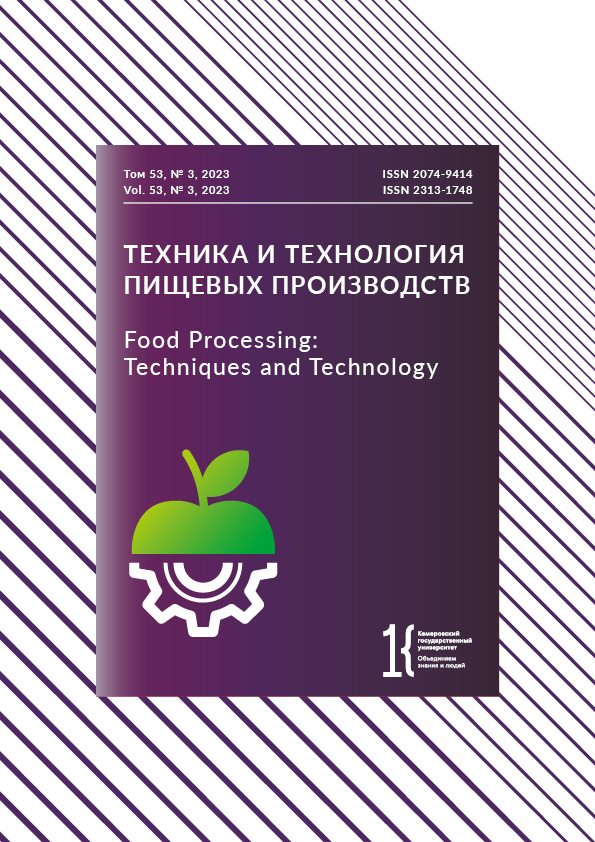Moscow, Russian Federation
Moscow, Russian Federation
Orel, Russian Federation
Spelt flour is rich in protein and adds nutritional value to bakery products, thus rendering them qualities of functional foods. The article introduces a new technology for preparing functional puff pastry with whole-grain spelt flour. The research featured yeast and yeast-free puff pastries made of whole-grain spelt flour. The samples obtained were analyzed with standard methods of sensory and physicochemical research and covered such variables as moisture content, acidity, quantity and quality of gluten, and falling number. The optimal share of whole-grain spelt flour amounted to 30% of total flour. The quality indicators met State Standard GOST 9511-80. The experiments made it possible to obtain the optimal formulations and technologies for yeast and yeastfree whole-grain spelt puff pastries with added nutritional value. The chemical composition and energy value per 100 g of finished product were determined by calculation. In the yeast puff pastry, adding 30% whole-grain spelt flour raised the protein content by 32.3%, carbohydrates by 31.7%, dietary fiber by 63.0%, and minerals by 43.2%. The fat increased only slightly, i.e., by 1.6%. In the yeast-free puff pastry, adding 30% whole-grain spelt flour raised the protein content by 13.5%, carbohydrates by 23.3%, dietary fiber by 3.6%, and minerals by 21.6%. The fat increase was also insignificant (2.5%). Whole-grain spelt flour proved able to expand the range of fortified puff pastries. The new yeast-free functional puff pastry demonstrated better consumer characteristics than the experimental sample with yeast.
Spelt, whole-ground spelt flour, flour products, puff pastry, non-traditional raw materials, fortification, nutritional value, quality
1. Khmeleva EV, Kandrokov RKh, Korolev DN, Penkova YuV. Baking properties of spelled flour. Bread products. 2018;11:44–47. (In Russ.). https://doi.org/10.32462/0235-2508-2018-0-11-44-47; https://www.elibrary.ru/YLSILJ
2. Rumyantseva VV, Yurchenko TI. Study of the influence of spelled flour on changes in the technological properties of wheat flour in the production of waffle dough. Technology and commodity science of innovative food products. 2022;6(77):12–17. (In Russ.). https://doi.org/10.33979/2219-8466-2022-77-6-12-16; https://www.elibrary.ru/NPCJSK
3. Kandrokov RKh, Balova ER. The influence of hydrothermal treatment on the yield and quality of spelled flour. Agrarian Bulletin of the Urals. 2018;(2):11. (In Russ.). https://www.elibrary.ru/XRRIAH
4. Korolev DN, Khmeleva EV, Penkova YuV. Development of technology for wheat bread using spelled flour. Scientific works of the North Caucasus Federal Scientific Center for Horticulture, Viticulture, and Winemaking. 2019;26:57–64. (In Russ.). https://www.elibrary.ru/TUXVOR
5. Dolgikh VV. The use of whole grain spelled flour in combination with lupine, flax and Jerusalem artichoke flour for the production of functional protein-spelt breads. Bread products. 2020;(8):41–45. (In Russ.). https://doi.org/10.32462/0235-2508-2020-29-8-41-45; https://www.elibrary.ru/SQBPFS
6. Fazullina OF, Ponomareva SM, Smirnov SO, Semenova LI. Selenium content in spelt, buckwheat, and vegetable pasta. Food Processing: Techniques and Technology. 2020;50(2):242–251. (In Russ.). https://doi.org/10.21603/2074-9414-2020-2-242-251
7. Kandrokov RKh. Effects of triticale flour on the quality of honey cookies. Foods and Raw Materials. 2023;11(2):215–222. https://doi.org/10.21603/2308-4057-2023-2-568
8. Magomedov GO, Lobosova LA, Malyutina TN, Rozhkov SA. Cupcakes with New Functional Ingredients for the Nutrition of Primary School Children. Storage and Processing of Farm Products. 2020;(2):112–122. (In Russ.) https://doi.org/10.36107/spfp.2020.249; https://www.elibrary.ru/GIWRUZ
9. Belyavskaya IG, Vrzhesinskaya OA, Kodentsova VM, Shatnyuk LN. Nutritional value of bakery products from spelt flour enriched with vitamins, ferrum and calcium. Bread products. 2020;(2):54–57. (In Russ.). https://doi.org/10.32462/0235-2508-2020-29-2-54-57; https://www.elibrary.ru/WNPGCM
10. Khmeleva EV. Spelt Grain Use in the Technology of Grain Bread of Increased Nutritional Value. Food Industry. 2023.8(1):64–73. (In Russ.). https://doi.org/10.29141/2500-1922-2023-8-1-7; https://www.elibrary.ru/KCGGFW
11. Sanzharovskaya NS, Romanenko DV, Rzaeva MMK. The expediency of using spelt flour and beet fibers in the technology of flour confectionery. Polzunovskiy Vestnik. 2022;(3):28–36. (In Russ.). https://doi.org/10.25712/ASTU.2072-8921.2022.03.004; https://www.elibrary.ru/UHEJXK
12. Sanzharovskaya NS, Romanova NN, Khrapko OP. Spelt flour in flour confectionery formulations. Polzunovskiy Vestnik. 2020;(1):41–45. (In Russ.). https://doi.org/10.25712/ASTU.2072-8921.2020.01.008; https://www.elibrary.ru/BAUMGI
13. Osipova GA, Khmeleva EV, Malchenko TV. Innovative technology for the production of pasta from spelt flour. Technology and the study of merchandise of innovative foodstuffs. 2021;(6):51–56. (In Russ.). https://doi.org/10.33979/2219-8466-2021-71-6-51-56; https://www.elibrary.ru/WKNNLV
14. Astakhov IYu, Kurochkin PP, Ignatov DD. Chemical composition and technological properties of flour spelled // innovative machinery and technology. 2015;1(2):59–62. (In Russ.). https://www.elibrary.ru/UAWVLF
15. von Buren M, Stadler M, Luthy Ju. Detection of wheat adulteration of spelt flour and products by PCR. European Food Research and Technology. 2001;212(2):234–239. http://doi.org/10.1007/s002170000230
16. Müller T, Schierscher‑Viret B, Fossati D, Brabant C, A Schori, Keller B, et al. Unlocking the diversity of genebanks: whole-genome marker analysis of swiss bread wheat and spelt. Theoretical and Applied Genetics TAG. 2018;131:407–416. https://doi.org/10.1007/s00122-017-3010-5
17. Schober TJ, Kuhn M. Capillary zone electrophoresis for gliadin separation: applications in a spelt breeding program. European Food Research and Technology. 2003.217:350–359. https://doi.org/10.1007/s00217-003-0740-1
18. Sun Q, Wei Y, Ni Z, Xie C, Yang T. Microsatellite marker for yellow rust resistance gene Yr5 in wheat introgressed from spelt wheat. Plant Breeding. 2002;121(6):539–541. https://doi.org/10.1046/j.1439-0523.2002.00754.x
19. Afzal M, Pfannstiel J, Zimmermann J, Bischoff SC, Würschum T, Friedrich C, et al. High-resolution proteomics reveals differences in the proteome of spelt and bread wheat flour representing targets for research on wheat sensitivities. Scientific Reports. 2020;10:14677. https://doi.org/10.1038/s41598-020-71712-5
20. Weckx S, Allemeersch J, Van der Meulen R, Vrancken G, Huys G, Vandamme P. Metatranscriptome analysis for insight into whole-ecosystem gene expression during spontaneous wheat and spelt sourdough fermentations. Applied and Environmental Microbiology. 2011;77(2):618–626. http://doi.org/10.1128/AEM.02028-10
21. Mankevičiene A, Jablonskyte-Rašče D, Maikšteniene S. Occurrence of mycotoxins in spelt and common wheat grain and their products. Food Additives and Contaminants: Part A. 2014;31(1):132–138. https://doi.org/10.1080/19440049.2013.861614
22. Desheva G, Kyosev B, Sabeva M, Deshev M. Genetic variation of gliadins and some quality characteristics in spelt wheat. Bulgarian Journal of Agricultural Science. 2021;27(3):541–554.
23. Afzal M, Pfannstiel J, Zimmermann J, Bischoff SC, Würschum T, Longin CFH. High-resolution proteomics reveals differences in the proteome of spelt and bread wheat flour representing targets for research on wheat sensitivities. Scientific Reports. 2020;10:14677. https://doi.org/10.1038/s41598-020-71712-5
24. Kosakivska IV, Vasyuk VA, Babenko LM, Voytenko LV. Drought stress effects on Triticum spelta l. structural and functional characteristics. Journal of Stress Physiology and Biochemistry. 2018;14(1):12–18.
25. Cole EW, Fullington JG, Kasarda DD. Grain protein variability among species of Triticum and Aegilops: quantitative SDS-PAGE studies. Theoretical and Applied Genetics. 1981;60:17–30. http://doi.org/10.1007/BF00275173
26. Onishi I, Hongo A, Sasakuma T, Kawahara T, Kato K, Miura H. Variation and segregation for rachis fragility in spelt wheat, Triticum spelta L. Genetic Resources and Crop Evolution. 2006;53:985–992. http://doi.org/10.1007/s10722-004-7068-y
27. Blatter RHE, Jacomet S, Schlumbaum A. Spelt-specific alleles in hmw glutenin genes from modern and historical european spelt (Triticum spelta L.). Theoretical and Applied Genetics. 2002;104:329–337. https://doi.org/10.1007/s001220100680











